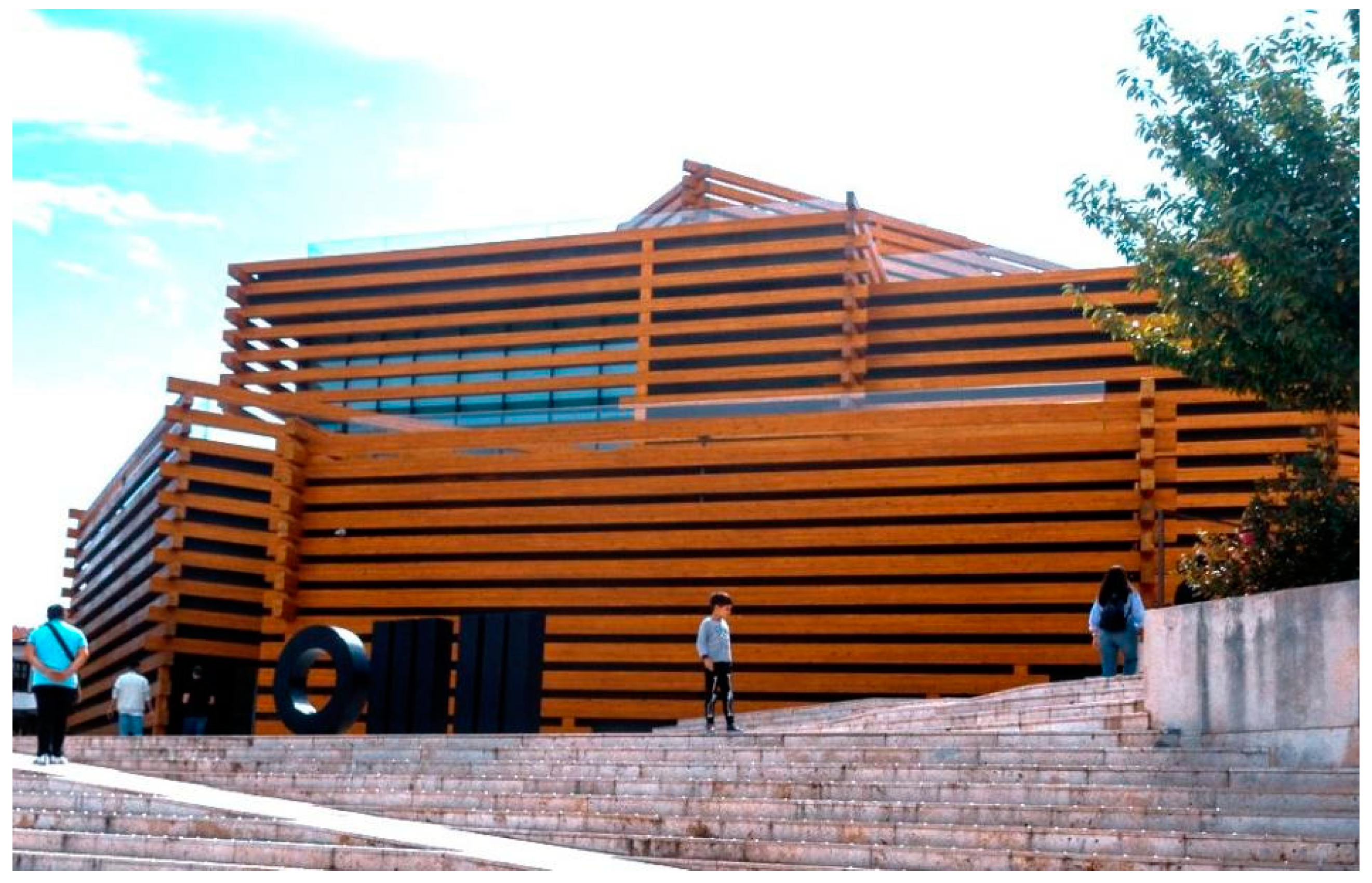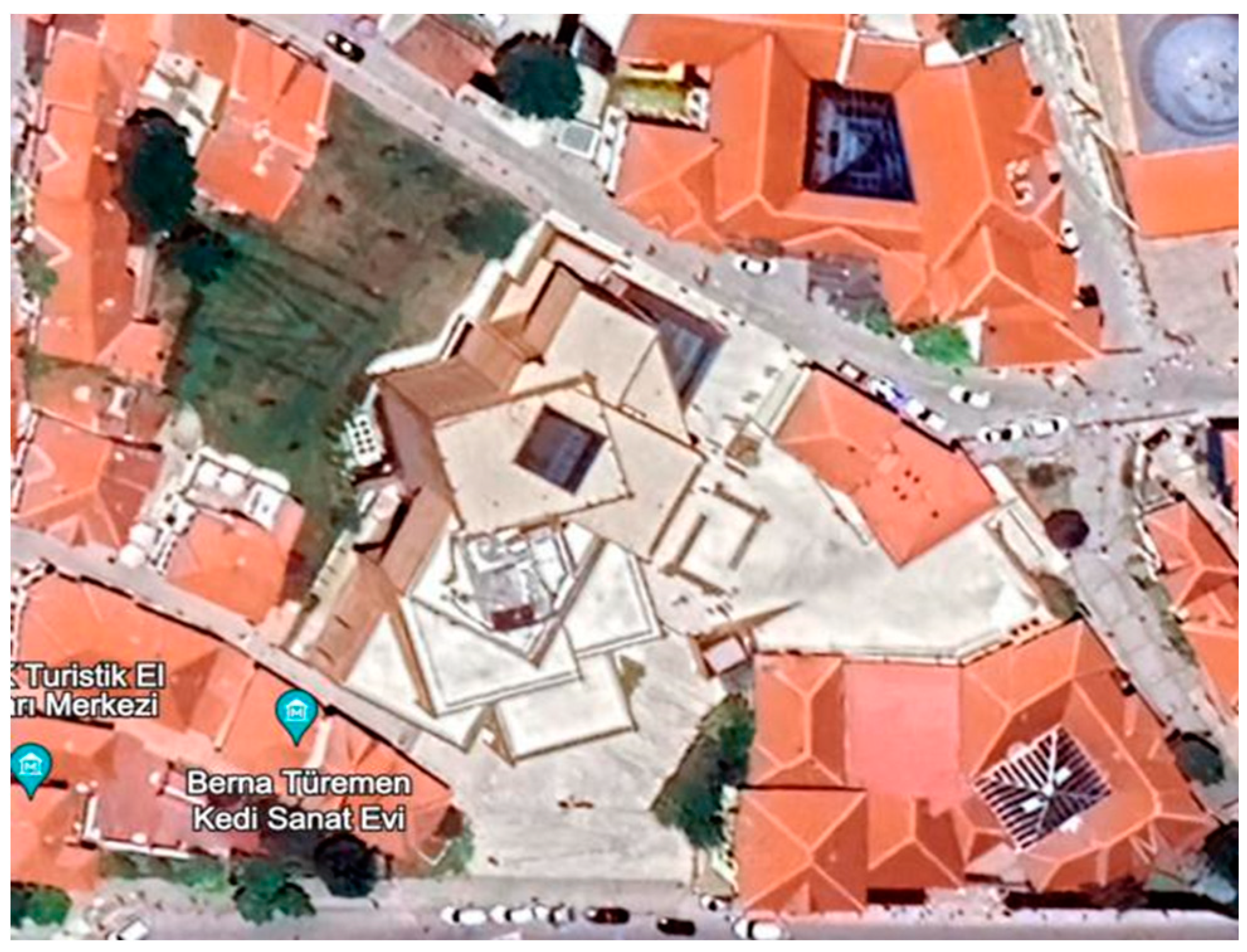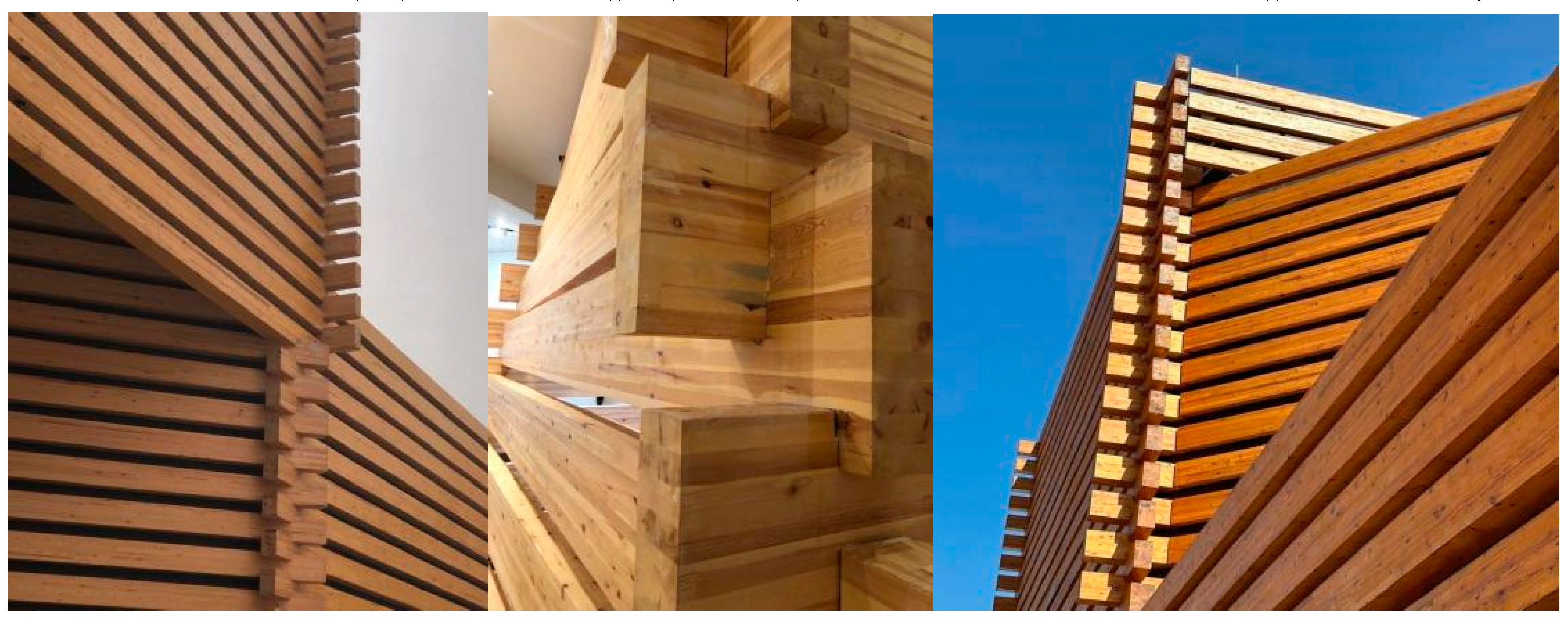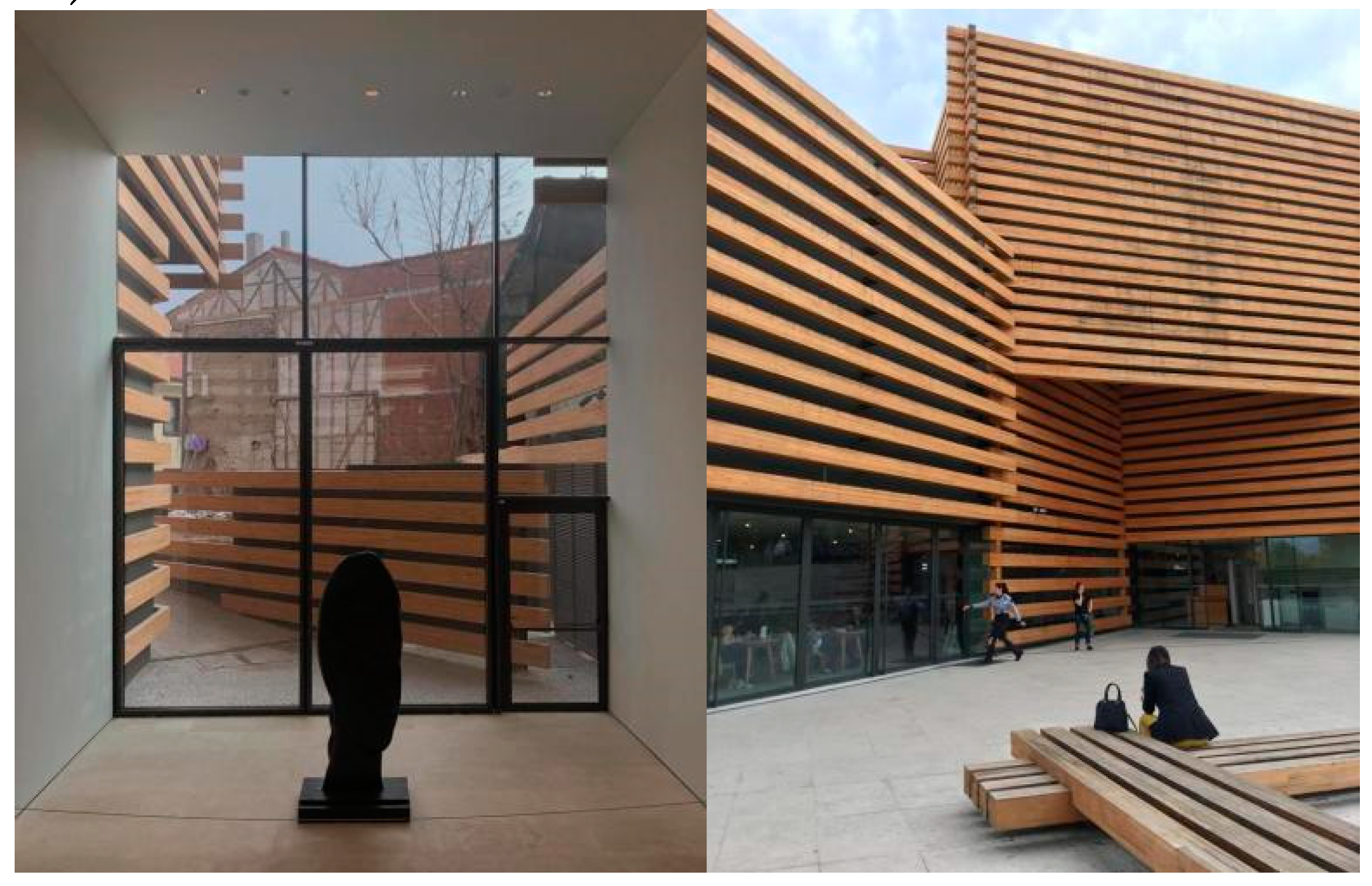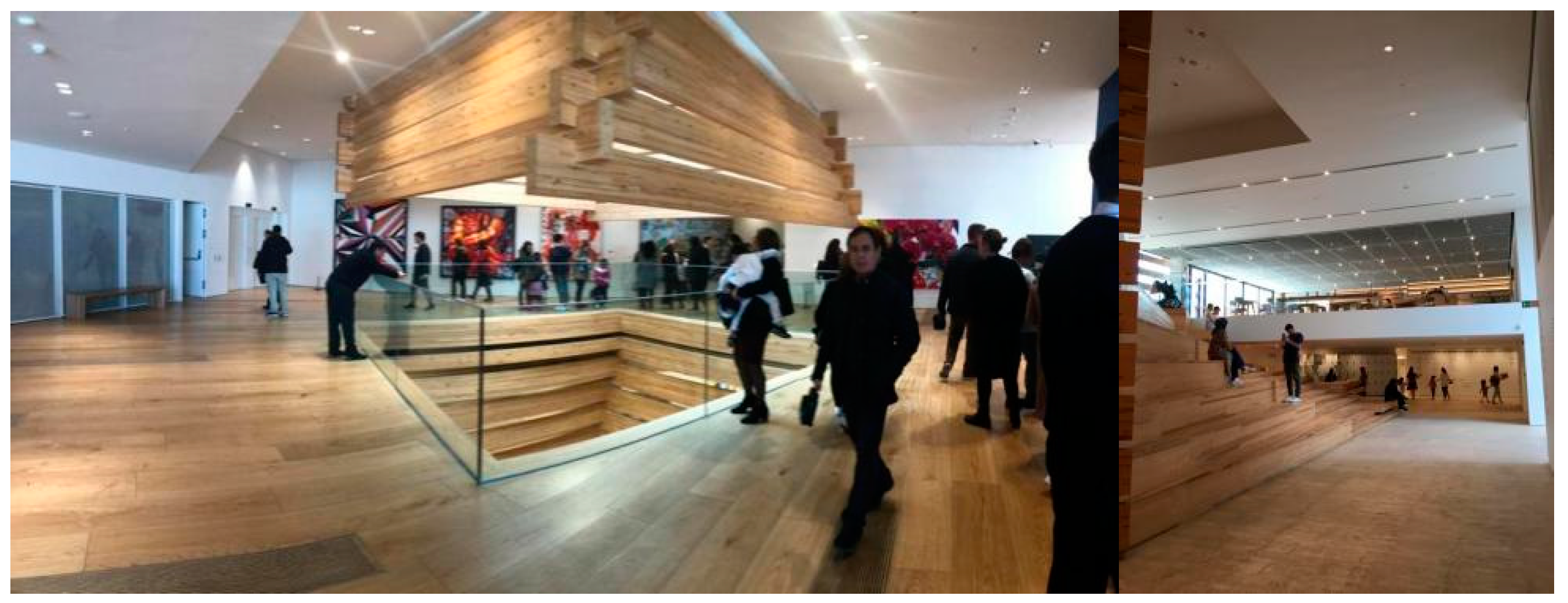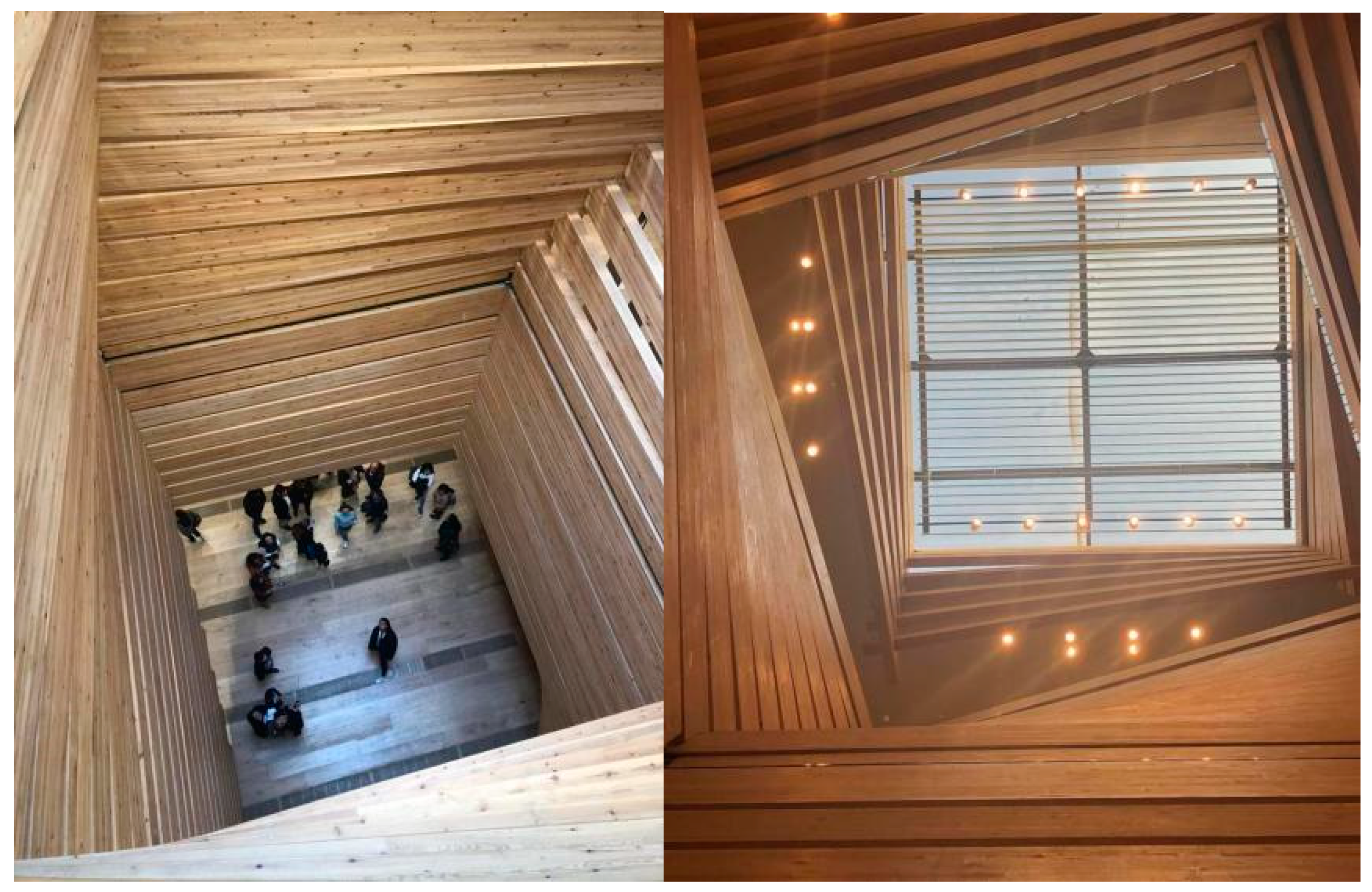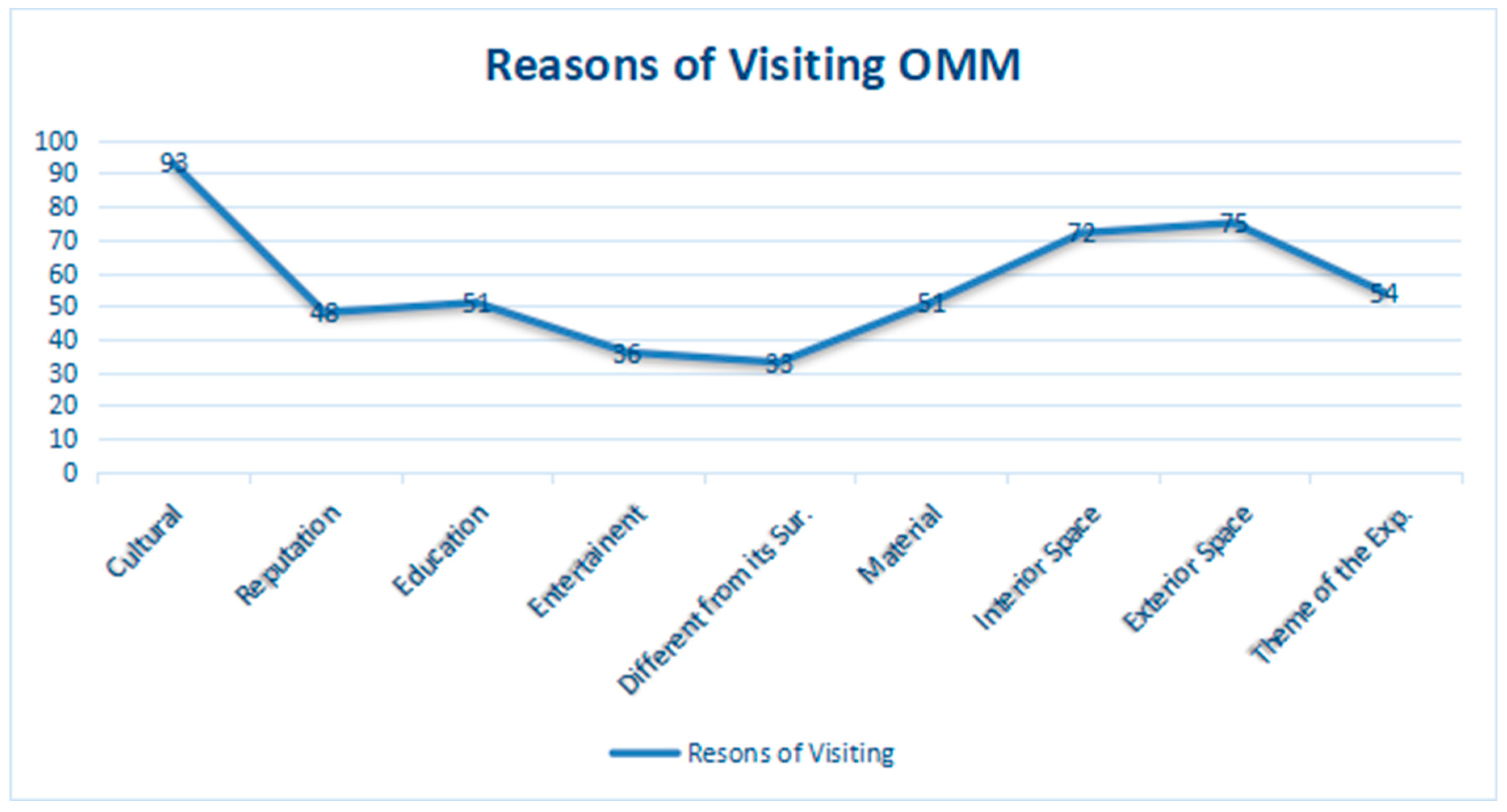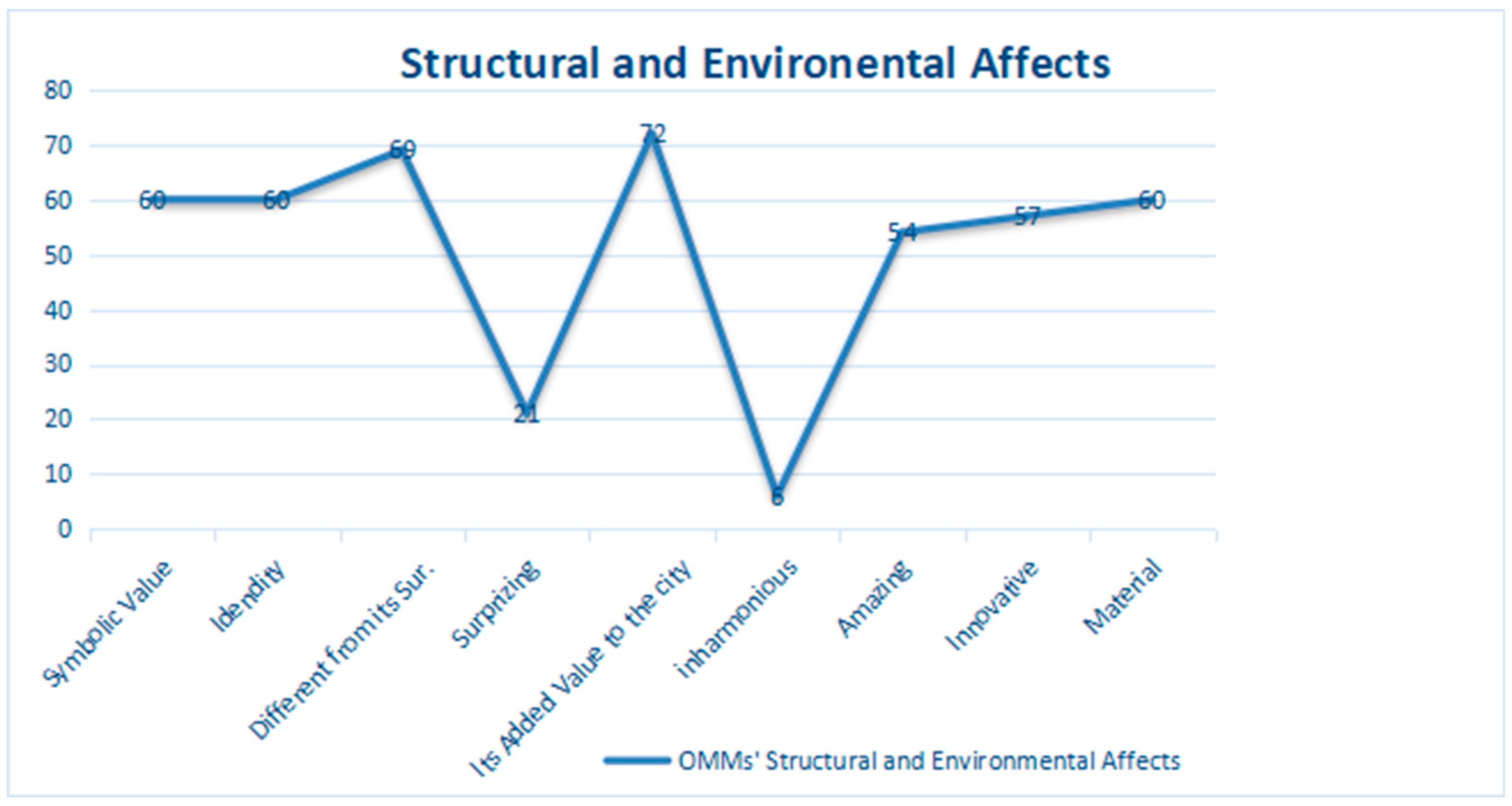1. Introduction
With technological advancements and shifting societal needs, construction materials are continually undergoing diversification and renewal within their structural applications. The selection of material assumes a critical role in the development of spatial design, influencing facets such as form, surface texture, physical and chemical structure, fluidity, and the foundational philosophies embedded in design approaches [
1]. Therefore, a thorough examination of the physical and psychological effects of these materials is imperative. Understanding the impact of material features on users and recognizing the opportunities this impact presents are pivotal. This study examines wood as a construction material that boasts extensive and diverse global usage and presents advantages in production, availability, trade, and ecological impact, positioning it as a renewable natural resource characterized by a commendable strength-to-mass ratio [
2]. Moreover, its positive contribution to carbon storage aligns with the growing emphasis on eco-friendly construction practices [
3]. The surge in green construction has underscored the importance of utilizing renewable materials, with wood emerging as a key component of environmentally sustainable structures [
4]. Wood's ready availability, lightness, durability, and ease of processing, coupled with its diverse natural characteristics, further differentiate its applicability based on spatial, environmental, and structural objectives.
In-depth studies of the technical and functional properties of wood extend beyond its physical characteristics to encompass its effects on user experience, spatial perception, and sensory engagement. Wood, as a material, not only contributes to spatial creation but also holds cultural and historical significance, providing aesthetic satisfaction and influencing psychological and physical aspects [
1].
This study comprehensively explores the multifaceted aspects of wood through a literature review and a case study of the Odunpazarı Modern Museum (OMM). The OMM, designed by Kengo Kuma, serves as a unique structure that exemplifies the various applications and influences of wood on one structure. The investigation involved a questionnaire to assess users' spatial experiences within the OMM. Beyond the OMM's impact on its physical identity, encompassing location, design applications, and urban integration, modern museums significantly contribute to the social life of their surroundings by evoking diverse feelings and emotions among users.
In contrast, situated in Eskisehir, with a historical background of wood sources, OMM's thick laminated wooden beams reflect the street texture from the Ottoman period. The formal features of OMM align with Kengo Kuma's architectural style, emphasizing “Addition and Integration” in form creation, and utilizing wood to add comfort and warmth to its surroundings. Kuma's preference for natural materials, particularly wood, reflects a deliberate effort to establish a sustainable connection between people and their living environments, diverging from the predominant use of concrete and steel in contemporary architecture [
1].
1.1. Odunpazarı Modern Museum (OMM)
The OMM assumes a pivotal role as a transportation axis for Eskişehir, Akin to Atatürk Boulevard, solidifying its connection with the city by strategically situating itself on this thoroughfare. Encompassing approximately 4,500 m², the museum integrates exhibition spaces, event venues, cafés, workshops, and museum shops. Entrances to the three-floor museum are provided from the +3.50 level, featuring a cafeteria and museum shop, with works exhibited at elevations of 0.0 – +8.00, and +13.80, and warehouses located at the -5.00 level.
Figure 1.
Exterior view of Odunpazarı Modern Museum (OMM).
Figure 1.
Exterior view of Odunpazarı Modern Museum (OMM).
Upon closer examination of the OMM, it becomes evident that the guiding design principles or concepts, specifically "geometry," "light," "clustering," and "wood"—are thoughtfully implemented in the completion of the structure. The deliberate inclusion of wood among these thematic elements indicates a purposeful integration of natural materials indigenous to the geographical context, suggesting that the utilization of wood goes beyond a semantic connection with Odunpazarı. Physical structures within the built environment are subject to numerous variables that collectively shape the experience of individuals. These variables encompass specific qualities of the structures, their functional values, integration into the urban fabric, visibility, accessibility, and the impressions and associations they evoke for the observer.
Odunpazarı is the sole area in Eskisehir where traditional neighborhood characteristics persistently concentrate. Kursunlu Kulliye, constructed in 1516, serves as a landmark evidencing the area's historical significance during the Ottoman Period. Most houses in this region exhibit traditional architectural characteristics utilizing timber-frame construction systems. Identified as one of the central districts of Eskisehir, Odunpazarı thrives not only on tourism facilitated by the concept of "Odunpazarı Houses"—a trademark resulting from renovation and restoration projects within the district—but also maintains its historical prominence through the city's ongoing development (
Figure 2).
The design of the OMM intricately weaves the historical urban texture and cultural heritage of the region with the aim of establishing a new focal point that supports the traditional street texture.Upon scrutinizing user perspectives within well-defined conceptual frameworks, namely comfort level, satisfaction level, and perceptual benefit level, investigations unveil discernible distinctions across diverse age groups, occupational categories, educational levels, and socio-demographic characteristics. Specifically, crafted wooden exterior-covering materials envelop the museum, underscoring the significance of wood in the city's heritage, which is known to provide comfort and a warm atmosphere. This architectural endeavor seeks to forge a symbiotic link between society and art, positioning itself at the heart of the structure. By focusing on the Odunpazarı street texture and human scale, the building creates diverse experiential dimensions within itself, leaving a lasting impact on the city's historical narrative and aspiring to be recognized as a landmark carrying its memory. Beyond its physical attributes, such as location, design decisions, and integration with the urban fabric, the OMM significantly shapes the social space in its immediate surroundings by evoking a range of emotions and sentiments from users.
1.2. Structural Effect of Wood on OMM
In addition to tracing the historical evolution of wooden material utilization in construction, its cultural entanglements, and the psychological and aesthetically gratifying effects it imparts on daily life, its physical attributes are significant in shaping spatial and environmental characteristics.
OMM’s structural system comprises three distinct sections: a masonry base, timber-framed upper section, and timber roof section. The foundation and basement floors are constructed using rubble stone or mud brick, incorporating horizontal timber beams for reinforcement. The timber-framed upper section is characterized by the integration of horizontal, vertical, and diagonal elements, forming continuous panels and boxes. Notably, the structural joints employed include the full lap joint, utilized to create a “T” joint from timbers of varying depths, while the half-lap joint (also known as the “halving” joint) is employed to join timbers of similar depths [
5] (
Figure 3).
The differentiation in the natural texture of wood is contingent upon various factors, including the tree type, climatic exposure, harvesting conditions, drying methods, baking duration, and post-harvest storage. The OMM employs an intricate interplay of wooden elements in both interior and exterior space, revealing distinctive characteristics. Although typically differentiated, the discussion allows for the consideration of interior surfaces as analogous to facades, elucidating the exceptional craftsmanship evident in the OMM. Comprising yellow-laminated Russian pine, each surface, approximately 14 meters long and weighing 350 kilograms, plays a pivotal role in both exterior and interior spaces, offering a natural material conducive to light-shadow effects due to its inherent texture and physical properties. The repetitive arrangement of these wooden elements, coupled with their alignment, geometric form, and response to light conditions, yields diverse textures shaped by the interplay between light and shadow [
6]. The impeccable attention to manufacturing details, from precise assembly to decorative elements resembling energy outputs on the floor, underscores this meticulous approach. In interior spaces, the structure yields numerous facades that transcend conventional museum walls. Remarkably, the building's facade remains perceptible from the interior to the exterior space, even when considering the disassembly of the masses.
1.3. Environmental Effect of Wood on OMM
Environmental identity is a component of an individual’s self-concept, and represents a sense of connection to a specific segment of the non-human natural environment. This connection is established through factors such as historical ties, emotional attachments, and perceived similarities. The formation of environmental identity influences individuals' perceptions and behaviors toward the world, shaping their sense of self in relation to their natural surroundings [
7].
In the contemporary urban milieu, the re-evaluation of cities necessitates collaborative efforts from architectural disciplines, local governments, and urban planning to articulate and brand cities within the global system. Architects Peter Rich and Kengo Kuma, aligned with the principles of "anti-object," underscore the ease of creating forms and the rediscovery of traditional architecture for 21st-century design [
8]. The OMM, aligns with this philosophy, assuming a distinctive identity through its physical environment, contributing to the city's brand by accentuating aspects that add value. Beyond its physical attributes such as location, design decisions, and urban texture integration, OMM significantly shapes the social space in its vicinity by eliciting diverse emotions and sentiments from users [
9].
The claim that the OMM "recreates the traditional street" within its interior circulation may provoke debate. Nevertheless, the undeniable spatial richness within 3,582 square meters is evident, characterized by non-uniform sub-units in the plan, elevation differences, and triangular staircases, all of which contribute to curator satisfaction. The building's consistent engagement with the city and the integration of semi-open spaces deviate from the conventional "white walls" adopted by modern museums [
10] (
Figure 4).
Functioning as a determinant of cosmic order in the interplay between interior and exterior realms, the OMM allows for the direct perception of seasonal, daily, and instantaneous changes through the senses.
1.4. Spatial Effect of Wood on OMM
As a fundamental aspect of design principles, interior design assigns significant importance to the effective utilization of materials. This importance is attributed to the OMM design setup, such as the characteristics of the wood materials used in the structural surfaces and furniture within the space. The significance is contingent on elements such as the nature of the material used, the manner in which the material is employed, and the distribution of light [
11].
Various types of wood exhibit distinct characteristics in terms of texture, scent, and appearance. Solid wood, employed as a veneer, accessory, and furniture material, is sourced domestically and internationally and is now finding applications in interior spaces [
12]. Recognizing the diverse dimensions of wood usage in the OMM—cultural, historical, sociological, psychological, and demographic—through which the visual qualities of this material interact with individuals and societies, and considering an interdisciplinary approach, research has gained significance. The establishment of relationships that influence perception, meaning, and behavior is crucial, as is the utilization of applied techniques [
13] (
Figure 5).
As previously mentioned, in response to advancing technology and evolving demand, there is continuous diversification and renewal of construction materials. The application areas of interior design, encompassing walls, floors, cladding, and furniture, are entirely constituted by the utilization of these materials. The OMM also includes various species of wood that possess textures, scents, and visual attributes derived from nature. Solid woods that are both domestically sourced and imported are employed as coverings, accessories, and furniture materials, thus expanding their utility in interior spaces [
14]. The adaptability of wood to various applications is contingent on its physical attributes, including its resistance to environmental conditions. Conceptualizing the "courtyard" as the foundational element of the microcosmic space, the design seamlessly incorporates natural elements, fostering continual reconsideration of the dynamic interaction between nature and humanity [
15]. The articulation of wooden elements heightens the spatial density, and their dynamic effect, which is influenced by their grouped arrangement and the interplay of light, results in a visually intricate braiding effect (
Figure 6).
1.5. Research Question
This study focused on a comprehensive analysis of the physical attributes of wooden materials, encompassing considerations related to interior and exterior spaces, built-in furniture applications, and user experience. Correspondingly, it examined the cultural, psychological, and esthetic sensory effects of wood material within the context of a museum, utilizing it as a case study.
Consequently, this study uncovered and analyzed the interior, exterior spatial, and built-in furniture wood material experiences and involved impact assessments of visitors situated in the sample area. The hypotheses were as follows:
H1: The perception of wood material will be more pronounced when observed from the exterior rather than the interior spaces of the OMM.
H2: Participants will perceive the OMM more as a unique rather than symbolic structure.
H3: Most visitors will express that the repetition of wood in the exterior, interior, and built furniture of the OMM is monotonous or boring.
2. Materials and Methods
The research design was shaped through a comprehensive analysis of the literature, comprising a case study (observation and analyses) and questionnaire, aiming to understand the interior, exterior spatial, and built-in furniture wood materials. By amalgamating the findings from the research and the insights gathered, a design framework was established to obtain psycho-social data regarding one unique material as a whole.
A literature review was initially conducted of wood material and effects of wood as a building material, physical and psychological effects on the user, advantages of the material, and so forth. Consistent with the information and criteria obtained, a case study was considered appropriate. Survey data were examined by document analysis.
Survey questions were developed based on a comprehensive literature review. The survey, comprising four sections, began with four questions that collected participants' demographic information. The second section consisted of three questions targeting the research questions, utilizing various concepts to measure the participants' perceptions of the field. The third section assessed the impact of wooden material usage through two questions, which were evaluated on a five-point Likert scale ranging from 1 to 5. The final section presented an open-ended question that invited participants to provide qualitative insights. This methodologically sound survey design and its application underscored a commitment to rigorous research practices, ensuring the collection of diverse and meaningful insights from participants.
This study was conducted in 2023, between 1 Jun and 21 December with visitors to the OMM who were living in or outside Eskişehir. Respondents were randomly selected from among the visitors to the OMM; 117 completed questionnaires were obtained.
3. Results
The survey, which focused on the use of wooden materials, was administered to a randomly sampled selection of 117 individuals who visited the OMM. The demographic information of the participants is presented in
Table 1. Among the participants, a notable sex difference was observed, with 76.9% identifying as women and 23.1% as men. It is noteworthy that all respondents had educational qualifications at the university level or beyond. In terms of age demographics, 45% of the participants fell within the 18–25 age bracket, 41% were in the 26–35 age range, 18% were in the 36–45 age category, and 9% were in the 46–55 age cohort. Of the visitors, 87.2% did not live in Eskişehir. The demographic data provide a valuable foundation for subsequent analyses and interpretation, contributing to a nuanced understanding of the impact of wooden material usage in the context of the museum visitation experience.
| Case Processing Summary of Reliability Statistics |
| |
N |
% |
| Cases |
Valid |
117 |
100,0 |
| Excluded |
0 |
,0 |
| Total |
117 |
100,0 |
|
Notes: a. Listwise deletion based on all variables in the procedure. |
| Reliability Statistics |
| Cronbach's Alpha |
N of Items |
| ,897 |
10 |
Table 1.
Demographic Information.
Table 1.
Demographic Information.
| Demographic Characteristic |
Value |
Total |
| F |
% |
F |
| Gender |
Female |
90 |
76,9 |
117 |
| Male |
27 |
23,1 |
| Age |
18-25 |
45 |
38,5 |
117 |
| 26-35 |
41 |
35,0 |
| 36-45 |
18 |
15,6 |
| 46-55 |
9 |
22.9 |
| Education |
Undergraduate |
63 |
54,9 |
117 |
| Master |
36 |
30,8 |
| PhD |
18 |
15,4 |
Are you living in Eşkişehir?
| n= 117 |
Percentage |
Number |
| Yes |
12,8% |
15 |
| No |
87,2% |
102 |
Participants were asked “How important was it for you to visit OMM on your trip to Eskişehir?” Approximately 61.5% of respondents articulated the importance of including a visit to OMM in their itineraries when traveling to Eskişehir. This underscores the institutional significance of the museum for these individuals and elucidates its pivotal role within the framework of their visits to the city.
| N = 117 |
Strongly Disagree |
Disagree |
Neither Agree nor Disagree |
Agree |
Strongly Agree |
| Percentage |
2,6 |
5.1 |
15.4 |
61.5 |
15.4 |
| Number |
3 |
6 |
18 |
72 |
18 |
Table 2 delineates the responses and corresponding values elicited from the participants in the study, focusing on the nuanced effects of wooden material utilization pertaining to the interior-exterior nexus and the experiential and perceptual dimensions of movable and structural furniture within the interior milieu. The scale used to evaluate the impact of wooden material usage on the interior-exterior relationship ranged from 1 (Strongly Disagree) to 5 (Strongly Agree). Participants rated descriptors such as "material continuity," "interior-exterior harmony," "identity," "natural," and "unique," all of which collectively underscore the substantive import of wooden material employment within the architectural framework. Notably, expressions such as "natural" garnered predominantly affirmative ratings, with participants overwhelmingly indicating robust agreement (5) regarding its pivotal role in augmenting the interior-exterior synergy.
Concurrently, the ramifications of wooden material usage on the experiential and perceptual dimensions of interior spaces, specifically within the purview of movable and structural furniture, were examined using a scale ranging from 1 to 5. Participants rated terms such as "material continuity, "interior-exterior harmony," "identity,” “warm atmosphere," "welcoming," and "natural," which underscore the intrinsic significance of wooden material applications in imparting these transformative effects to the occupant. Of particular note is the consistent attribution of affirmative evaluations, particularly for the term "warm atmosphere," with participants predominantly concurring and rating it as "Agree (4)" in the context of assessing wooden material utilization within the realm of movable and structural furniture. However, participants expressed that the use of wooden materials in both indoor and outdoor spaces, as well as in furniture, was perceived as non-monotonous.
Participants were asked "For what reason or reasons would you visit OMM?" The answers to the question are shown in
Figure 7. The main reason for visiting was "cultural," with 93% of respondents endorsing this response. The architectural and interior value of the building were also among the reasons for visiting the OMM, as reported by 75% and 72% of the participants, respectively. In contrast, the lowest percentage was found for the criterion of "being different" of the structure.
The answers to the question "Describe the effect of the building and its environment on you” are shown in Table 4. "The value the building adds to the city" was found important by 72% of the participants. Most participants had the same opinion regarding the harmony of the building with its environment. In this context, the option "Incompatibility with its environment,” which is among the effects, had the lowest rate of endorsement among the options, with 6% of the participants concurring. “Being a city symbol,” “Identity value,” and “Material” were endorsed by 60% of the participants.
The last question asked to the participants was, "Is there any topic(s) you would like to add, other than those mentioned above, regarding the structural, environmental and spatial properties of wood material on the structure. With an open-ended question are the following command given below;
Table.
Comparison Regarding the Reasons of OMM.
Table.
Comparison Regarding the Reasons of OMM.
| |
The Commands Provided by the Open-Ended Questions |
| C1 |
The building has a semantic value as well as its structural, environmental and spatial features |
| C2 |
the material and structure are highly integrated and it is stated that the wooden material used in the exterior, interior and furniture are complementary and provides a holistic experience |
| C3 |
The building establishes a harmonious relationship with its environment and the wooden material, an innovative interpretation. |
| C4 |
The harmony of the interior-exterior relationship with the experience provided on the façade with the amphitheater area is provided also in the interior with the wooden cage constructed in the core. |
| C5 |
Displaying the joining details of the wooden pillars gives the building a sculptural appearance. |
| C6 |
Wooden material used in the building creates a cultural bond with its environment. |
| C7 |
One of the participants drew attention to the fire risk of the building. |
4. Discussion and Conclusions
Given the evaluations, an analysis was performed on how the usage of wood material, the structural, spatial and interior atmospheric and in what manner OMM is affected by the environmental conditions within which it exists, and how it contributes to its context. Four main elements stood out in the design of the OMM: the form organization, incorporation of natural light into the structure, and material selection. The architectural language of the structure emphasizes the interpretation and utilization of local architectural elements, materials, and construction techniques. The design is site-specific, considering harmony with the terrain, environmental context, human scale, and tactility with an international perspective.
A notable 87.2% of survey participants revealed that they do not reside in Eskişehir. This demographic characteristic lends significance to the role of OMM as a cultural institution in fostering an understanding of the building's importance for the city among non-local visitors. Moreover, a substantial portion of respondents, comprising 61.5% expressing it as "Important" and 15.4% as "Very Important," underscored the significance of incorporating a visit to OMM into their itineraries when journeying to Eskişehir. This attests to the perceived value and relevance of OMM as a destination of cultural interest for travelers exploring the city.
In the second segment, the utilization of wood in OMM's structural, interior, and exterior spaces was assessed employing the 'Likert technique.' The evaluation encompassed key aspects such as material continuity, interior-exterior harmony, identity, warm atmosphere, welcoming ambiance, flexibility, monotony, natural aesthetics, simplicity, and uniqueness. The recorded values exhibited a noteworthy convergence, ranging closely between 3.7 and 4.2 for criteria other than monotony. However, the monotony criterion received ratings of 2.44 and 2.77. Consequently, it is deducible that visitors deem the incorporation of wood significant across all assessed criteria within this architectural framework, with the exception of the monotony aspect where opinions are somewhat more divided.
In the comparison tables, diverse reasons for visiting OMM, such as cultural exploration, educational enrichment, entertainment, the uniqueness of its materials, and the thematic quality of its interior and exterior spaces, were subject to evaluation through the assignment of ratings to multiple criteria. Similarly, assessments regarding the building and its environmental impact, including symbolic value, identity, distinctiveness, surprise factor, perceived value for the city, harmony, amazement, and innovation, were appraised across various dimensions.
Notably, the rationale behind visiting OMM that received the lowest ratings was identified as 'entertainment' in the first table, coupled with the perception of 'inharmonious surroundings.' In the second table, the aspects with the least impact on OMM were determined to be 'surprising' and 'inharmonious.' Despite these lower ratings in specific categories, the majority of respondents regarded all other criteria mentioned in both tables as significant. This underscores a prevailing acknowledgment of OMM's importance across diverse factors, with only isolated considerations receiving comparatively lower ratings.
H1: The perception of wood material was more pronounced when observed from the exterior rather than the interior spaces of the Odunpazarı Modern Museum (OMM).
Given that the exterior perception has been rated at 4.15 and the interior perception at 4.05 by visitors, the very slight difference between these values suggests that, from a statistical standpoint, the variation is not deemed significant in terms of people's perception. The marginal discrepancy in ratings indicates a close alignment in how visitors perceive both the exterior and interior aspects of the facility, with no substantial difference in their assessments. This lack of a significant variance underscores a consistency in the positive perception of both the exterior and interior components of the space by the surveyed individuals.
H2: Participants will perceive the OMM more in terms of its material rather than its exhibition theme
This hypothesis was supported. Visitors rated OMM material with an average score of 51, and the theme of the exhibition as 34. Thus, the structural materials were of interest.According to visitor ratings, OMM's material received a score of 51, while the theme of the exhibition garnered a rating of 34. This discrepancy in scores suggests that visitors find the structural material of OMM more captivating or interesting compared to the theme of the exhibition. The higher rating for the material aspect may indicate a particular appreciation for the architectural or construction elements of OMM, emphasizing the significance of the physical and tangible aspects of the museum's structure in the eyes of the visitors.
H3: Most visitors will express that the repetition of wood in the exterior, interior, and built furniture of the OMM is monotonous or boring.
This hypothesis was rejected. Visitors rated the OMM’s continuous wood material as having the lowest value among all the criteria. On the Contrary, the opinions of the visitors reveal a distinct perspective, with 54 participants expressing their admiration by rating OMM as “amazing” and even larger number, 59 individuals, acknowledging the museums’ innovation. This signifies a substantial portion of the audience a substantial portion of the audience finding OMM to be not only impressive but also recognizing its innovative characteristics. Such positive assessments underscore the museums’ ability to captivate and engage visitors through its remarkable and remarkable and forward-thinking attributes.
The predominant response to the question of whether the structure has a unique relationship with the environment indicates that the building is perceived as having an original and interesting style. However, the participants seemed hesitant about its compatibility with the surroundings. This hesitation was attributed to the building's perceived large scale and height. Additionally, feedback suggested that the visually striking modern and new expressions of the structure do not align well with the city's identity. The reasons for this mismatch were identified in the responses to the open-ended questions, indicating a limited degree of suitability in terms of formal and scale-related compatibility with the surrounding structures.
At the open-ended part of the questionnaire many valuable commands have been added such as; OMM’s emphasis of semantic value in addition its structural, environmental and spatial features, wooden material which are complementary and provides a holistic experience. The structure adeptly establishes a harmonious relationship with its environment, a concept further echoed in the analogous use of the facade design in both the amphitheater and the internal wooden cage. The meticulous detailing of the wooden pillars, interpreted as a sculptural manifestation, not only enhances the aesthetic appeal but also serves as an illuminating addition, aligning seamlessly with OMM's objectives centered around the integration and thoughtful utilization of wood as a prominent material in the architectural narrative. This nuanced approach not only contributes to the overall visual cohesiveness of the design but also underscores the deliberate and meaningful incorporation of wood in realizing the artistic and functional aspirations of the OMM project.
The detailed research conducted on the wooden material within the Odunpazarı Modern Museum has unveiled its multifaceted dimensions. Both the interior and exterior spaces of the museum, along with its cultural integration into the surrounding environment, showcase an intricate and integral relationship between structural elements, furniture, and the utilization of wooden materials. In essence, the museum functions as an open laboratory for scholarly investigation, encompassing a myriad of layered and comprehensive components.
The material, wood, emerges as more than a mere building block; it serves as a conduit for exploring and understanding cultural, environmental, psychological, sociological, technical, detailed, colorful, textured, user centred, meaningful, perceptual, design-oriented, and identity-driven aspects. It becomes a lens through which one can examine principles of design, sustainability, and a host of other considerations.
In the contemporary landscape, diverse design approaches, technologies, and the incorporation of smart and up cycled materials are continually evolving. However, the essence lies in comprehending and harnessing the full spectrum of each material, technique, or application. The study exemplifies this imperative by vividly demonstrating how wood, in its myriad dimensions, serves as a rich source for exploration and understanding across a broad spectrum of disciplines and considerations.
Appendix A
The appendix is an optional section that can contain details and data supplemental to the main text—for example, explanations of experimental details that would disrupt the flow of the main text but nonetheless remain crucial to understanding and reproducing the research shown; figures of replicates for experiments of which representative data is shown in the main text can be added here if brief, or as Supplementary data. Mathematical proofs of results not central to the paper can be added as an appendix.
Appendix B
All appendix sections must be cited in the main text. In the appendices, Figures, Tables, etc. should be labeled starting with “A”—e.g., Figure A1, Figure A2, etc.
References
- Gezer, H. Malzemenin gizil güçlerinin mimariye katkısı. İstanbul Ticaret Üniversitesi Fen Bilimleri Dergisi 2012, 97-118.
- Rice, J.; Kozak, R.A.; Meitner, M.J.; Cohen, D.H. Appearance wood products and psychological well-being. Wood Fiber Sci. 2006, 38, 644–659. [Google Scholar]
- Suh, W. D.; Nam, J.; Kim, Y. U.; Choi J., Y.; Kim, S. Thermal, structural, and chemical characteristics evaluation of wood/phase change material composites for applying as a finishing material in floor radiant heating systems. Constr. Build. Mater. 2023, 406, 133367. [Google Scholar] [CrossRef]
- Nasir, V.; Ayanleye, S.; Kazemirad, S.; Sassani, F.; Adamopoulos, S. Acoustic emission monitoring of wood materials and timber structures: A critical review. Constr. Build. Mater. 2022, 350, 128877. [Google Scholar] [CrossRef]
- Ashcroft, R. Construction for Interior Designers; The Longman Group UK Limited: England, 1992; pp. 271-272.
- Kuyrukçu, Y.; Elitok, M.K.A. Contextual approach To contemporary museum architecture: Odunpazarı Modern Museum example. J. Acad. Soc. Sci. 2021, 116, 187–201. [Google Scholar]
- Clayton, S.; Opotow, S. Identity and the Natural Environment: The Psychological Significance of Nature; The MIT Press, 2003; pp. 368.
- Savaş, A. OMM: Modern müze nedir?* Mimarlık Dergisi 2019, 410, 64-70.
- Erkara, B. Odunpazarı Modern Müze; Eskişehir Odunpazarı Modern Müze: İstanbul, Türkiye, 2019a; pp. 105-200.
- Kızılkan, G.; Yeşildal, Ö. Visual impact evaluation of a contemporary building in a historical pattern: Odunpazarı Modern Museum sampling area. J. Urban Stud. 2021, 32, 471–491. [Google Scholar] [CrossRef]
- Kolsal, F.; Koca, G. Historical, physical, and social development of Odunpazarı. Int. J. Soc. Sci. Humanit. 2015, 5, 557–560. [Google Scholar] [CrossRef]
- Ipekoğlu, B. An architectural evaluation method for conservation of traditional dwellings. Build. Environ. 2006, 41, 386–394. [Google Scholar] [CrossRef]
- Ashby, M.; Johnson, K. F. Materials and Design: The Art and Science of Material Selection in Product Design; Butterworth-Heinemann: Oxford, 2002; pp. 78.
- Odunpazarı Modern Müze/Museum. Büşra Erkara, Ed.; MAS Matbaacılık: İstanbul, 2009. [Google Scholar]
- Nyrud, A. Q.; Bringslimark, T. Is interior wood use psychologically beneficial? A review of psychological responses toward wood. Wood Fiber Sci. 2009, 42, 202–218. [Google Scholar]
|
Disclaimer/Publisher’s Note: The statements, opinions and data contained in all publications are solely those of the individual author(s) and contributor(s) and not of MDPI and/or the editor(s). MDPI and/or the editor(s) disclaim responsibility for any injury to people or property resulting from any ideas, methods, instructions or products referred to in the content. |
© 2023 by the authors. Licensee MDPI, Basel, Switzerland. This article is an open access article distributed under the terms and conditions of the Creative Commons Attribution (CC BY) license (http://creativecommons.org/licenses/by/4.0/).
